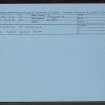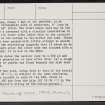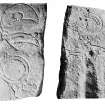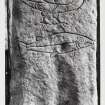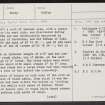Easterton Of Roseisle
Cist (Period Unassigned), Pictish Symbol Stone (Pictish)
Site Name Easterton Of Roseisle
Classification Cist (Period Unassigned), Pictish Symbol Stone (Pictish)
Canmore ID 16255
Site Number NJ16SW 26
NGR NJ 144 648
NGR Description NJ c. 144 648
Datum OSGB36 - NGR
Permalink http://canmore.org.uk/site/16255
- Council Moray
- Parish Duffus
- Former Region Grampian
- Former District Moray
- Former County Morayshire
Reference (1994)
(NJ c. 144 647). An irregular cist, discovered in the course of ploughing in 1894, had an unusual slab forming its W side; it bears incised symbols on both faces, including a crescent and V-rod and mirror and comb to the inside of the cist, and a fine incised goose and fish on the face that was hidden. The stone is now in RMS (IB 226).
RCAHMS 1994.
Reference (1997)
Class I symbol stone: on one face a goose above a salmon with on the other face a horseshoe above crescent and V-rod with a mirror-and-comb underneath.
A Mack 1997
Desk Based Assessment
NJ16SW 26 c. 144 648.
(Area: NJ 145 647) A cist of unusual plan, with a symbol stone built into its west side, was discovered during ploughing in 1894 and was subsequently excavated by Mr Dawson, tenant of Easterton, and Rev McEwan of Dyke. It lay about 400 yards east of NJ16SW 25, and 83 yards west and 8 yards south of the SW corner of NJ16SW 24, but in the same field. It lay N-S with an internal length of 4'2" and was composed of large rough slabs, one of which, on the east was over 3' high by 2' broad. The other sides were about 2' lower. It was paved with small stones 4" to 6" long. No cover slab was found but a large stone had been removed from the spot a year or two before the discovery.
There was evidence of bodies at both ends of the cist as well as two spots of black ashes, from which it was deduced that there had been either two bodies in 'sitting position', or two skulls with ashes of bodies. There were also ten or twelve oval or round white beach stones and two beach pebbles with marks of usage.
The symbol stone, Class 1 but of two periods, is an approximately rectangular slab of sandstone, 4' long by 1'10" wide by 2 1/2" thick. The front bears what may be the arch symbol or a crescent with a circular indentation in the middle of its lower side; below this is the crescent and V-rod and at the bottom is the mirror and comb. These appear to have been pecked with little attempt to smooth the line, and the weathering suggests that it stood as an earthfast upright after the other side was incised with a goose and a fish. It is now in the National Museum of Antiquities of Scotland [NMAS].
R B K Stevenson (NMAS) dates the earlier side to c.700 AD and the later to a generation or less after this. A rough axe of granite or quartz was found beneath the slab when it was removed.
(The siting of the cist, being tied to that of the burial ground (NJ16SW 24), is subject to the same confusion, so it has been located to area NJ 144 648, which is approximately 400 yards from the kiln (NJ16SW 25) in the direction of Taylor's siting of the burial-ground.)
Information from OS
H W Young 1895; J R Allen and J Anderson 1903; I C Walker 1968.














